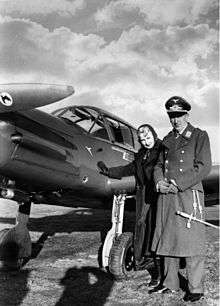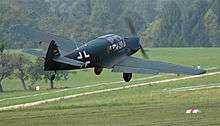Messerschmitt Bf 108 Taifun
The Messerschmitt Bf 108 Taifun was a German single-engine sport and touring aircraft, developed by Bayerische Flugzeugwerke in the 1930s. The Bf 108 was of all-metal construction.
| Bf 108 Taifun | |
|---|---|
| D-EBFW, a 1937-built Bf 108B-1 painted to represent a pre-war company demonstrator D-IBFW | |
| Role | Sport and touring aircraft |
| Manufacturer | Bayerische Flugzeugwerke |
| Designer | Willy Messerschmitt |
| First flight | 1934 |
| Introduction | 1935 |
| Retired | 1945 |
| Primary users | Luftwaffe Armée de l'Air Manchukuo National Airways |
| Number built | 885[1] |
| Variants | Nord 1000 Pingouin Nord Noralpha |
Design and development
Originally designated the M 37, the aircraft was designed as a four-seat sports/recreation aircraft for competition in the 4th Challenge International de Tourisme (1934).[2][3] The M 37 prototype flew first in spring 1934, powered by a 250 PS (247 hp, 184 kW) Hirth HM 8U 8.0 litre displacement, air-cooled inverted-V8 engine, which drove a three-blade propeller.
Although it was outperformed by several other aircraft in the competition, the M 37's overall performance marked it as a popular choice for record flights. Particular among these traits was its low fuel consumption rate, good handling, and superb takeoff and landing characteristics.
The Bf 108A first flew in 1934, followed by the Bf 108B in 1935. The Bf 108B used the substantially larger, 12.67 litre displacement Argus As 10 air-cooled inverted V8 engine. The nickname Taifun (German for "typhoon") was given to her own aircraft by Elly Beinhorn, a well-known German pilot, and was generally adopted.[4]
Operational history
Soon after the first production aircraft began to roll off the assembly line in Augsburg, several Bf 108s had set endurance records.
The Bf 108 was adopted into Luftwaffe service during World War II, where it was primarily used as a personnel transport and liaison aircraft. The aircraft involved in the Mechelen Incident was a Bf 108.
Production of the Bf 108 was transferred to occupied France during World War II and production continued after the war as the Nord 1000 Pingouin.
Variants

- Bf 108A
- Initial version designed in 1934 for use in Challenge 1934. Six were built with the Hirth HM 8U, one other initially had a 220 PS (217 hp, 162 kW) Argus As 17B inline engine and later a 160 PS (158 hp, 118 kW) Siemens-Halske Sh 14 radial.[4]
- Bf 108B
- Revised version, built from late 1935. The prototype had a Siemens-Halske Sh 14A radial, but production machines used the 240 PS (237 hp, 177 kW) Argus As 10C or the 270 PS (266 hp, 199 kW) Argus As 10E. A quadrant-shaped rather than rectangular rear window, tailwheel replacing skid, revision of shape of empennnage and removal of tailplane upper bracing.[4]
- Bf 108C
- Proposed high-speed version, powered by a 400 PS (395 hp, 294 kW) Hirth HM 512 engine. Probably not built.[4]
- Me 208
- Improved and enlarged version with a retractable tricycle landing gear. Two prototypes were built by SNCAN (Nord) in France during the war. After 1945 Nord continued its production as the Nord Noralpha.
- Nord 1000 Pingouin
- Bf 108 built during and after the war by SNCAN in France; followed by the Nord 1001, that had only minor variations and the Nord 1002, which used a Renault engine.
Operators


- Bulgarian Air Force Six aircraft purchased, used mainly for training.
- Chinese Nationalist Air Force
- Air Force of the Independent State of Croatia
- Czechoslovak Air Force operated this type postwar under designation K-70.
- Armée de l'Air operated captured Bf 108s and postwar-built Nord 1000 aircraft.
- Royal Hungarian Air Force operated seven Bf 108s from 1937 to 1945
- Manchukuo National Airways
- Royal Norwegian Air Force (Postwar)
- Polish Air Force operated a few captured Bf 108s postwar.
- Soviet Air Force operated several captured Bf 108s.
- Royal Air Force impressed four Bf 108s on the outbreak of World War II and put into service, who designated them "Messerschmitt Aldon". It was the fastest light communications aircraft the RAF had then, but they were often mistaken for Bf 109s. Postwar, 15 more captured Bf 108s flew in RAF colours.[4]
 RAF Aldon
RAF Aldon
- United States Army Air Corps - A single Bf 108B was purchased by the U.S. Military Attaché for Air in the spring of 1939 for $14,378 and designated XC-44. It was repossessed by the Nazi government in December 1941 (after having been condemned in November).
- Yugoslav Royal Air Force
Specifications (Bf 108B)
Data from Jane's all the World's Aircraft 1938,[5] Die Deutsche Luftrüstung 1933–1945 Vol.3 – Flugzeugtypen Henschel-Messerschmitt[6]
General characteristics
- Crew: 1 or 2
- Capacity: 2 or 3 pax
- Length: 8.29 m (27 ft 2 in)
- Wingspan: 10.5 m (34 ft 5 in)
- Height: 2.3 m (7 ft 7 in)
- Wing area: 16.4 m2 (177 sq ft)
- Airfoil: root: NACA 2416; tip: NACA 2413[7]
- Empty weight: 806 kg (1,777 lb)
- Gross weight: 1,350 kg (2,976 lb)
- Powerplant: 1 × Argus As 10C V-8 inverted air-cooled piston engine, 174 kW (233 hp)
- Propellers: 2-bladed variable-pitch propeller
Performance
- Maximum speed: 305 km/h (190 mph, 165 kn)
- Cruise speed: 260 km/h (160 mph, 140 kn)
- Landing speed: 85 km/h (53 mph; 46 kn)
- Range: 1,000 km (620 mi, 540 nmi) at 250 km/h (160 mph; 130 kn)
- Service ceiling: 6,200 m (20,300 ft) (with 3 pax + 50 kg (110 lb) baggage)
- Time to altitude: 1,000 m (3,300 ft) in 3 minutes 12 seconds
- 2,000 m (6,600 ft) in 7 minutes 30 seconds
- 3,000 m (9,800 ft) in 14 minutes
- 4,000 m (13,000 ft) in 22 minutes
- 5,000 m (16,000 ft) in 39 minutes
- Wing loading: 82.3 kg/m2 (16.9 lb/sq ft)
- Power/mass: 0.133 kW/kg (0.081 hp/lb)
See also
Related development
Aircraft of comparable role, configuration and era
Related lists
- List of military aircraft of Germany
- List of aircraft of the RAF
- List of military aircraft of the United States
References
Notes
- Smith 1971, p. 142.
- Schulz, R. and W. Pleines. "Technical Memorandums No. 760 - Technical Aspects of the 1934 International Touring Competition (Rundflug)." National Advisory Committee for Aeronautics, December 1934. Retrieved: 13 March 2010.
- Messerschmitt Bf 108 Taifun
- Smith 1971, pp. 36–37.
- Grey, C.G.; Bridgman, Leonard, eds. (1938). Jane's all the World's Aircraft 1938. London: Sampson Low, Marston & company, ltd. p. 136c.
- Nowarra, Heinz J. (1993). Die Deutsche Luftrüstung 1933–1945 Vol.3 – Flugzeugtypen Henschel-Messerschmitt (in German). Koblenz: Bernard & Graefe Verlag. pp. 187–189, 266–267. ISBN 978-3-7637-5467-0.
- Lednicer, David. "The Incomplete Guide to Airfoil Usage". m-selig.ae.illinois.edu. Retrieved 16 April 2019.
Bibliography
- Craig, James F. The Messerschmitt Bf. 109. New York: Arco Publishing Company, 1968.
- Cross, Roy and Gerald Scarborough. Messerschmitt Bf 109 Versions B-E (Classic Aircraft No. 2, Their History and How to Model Them). London: Patrick Stevens, 1972. ISBN 0-85059-106-6.
- Feist, Uwe. The Fighting Me 109. London: Arms and Armour Press, 1993. ISBN 1-85409-209-X.
- Grey, C.G. "Messerschmitt Bf 108." Jane's All the World's Aircraft, 1938. London: David & Charles, 1972. ISBN 0-7153-5734-4.
- Hitchcock, Thomas H. Messerschmitt Bf 108 Taifun (Monogram Close-Up 5). Acton, Massachusetts: Monogram Aviation Publications, 1979. ISBN 0-914144-05-7.
- Smith, J. Richard. Messerschmitt: An Aircraft Album. London: Ian Allan, 1971. ISBN 978-0-7110-0224-1.